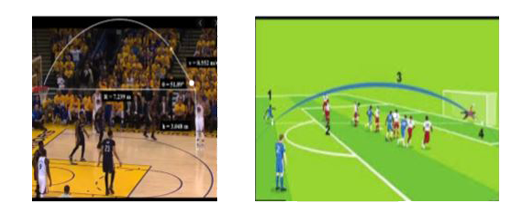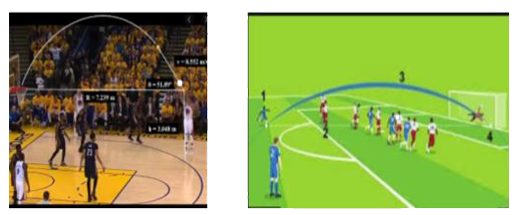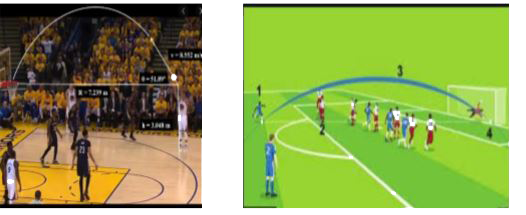To catch a fast cricket ball, a player pulls his hands backwards. Why ?
To understand why a player pulls his hands backward while catching a fast cricket ball, we can break down the explanation into several steps:
1. Understanding Momentum:
- When a cricket ball is moving towards a player at high speed, it possesses a significant amount of momentum. Momentum (p) is defined as the product of mass (m) and velocity (v): p=mv.
2. Conservation of Momentum:
- According to the law of conservation of momentum, in the absence of external forces, the total momentum before and after an event remains constant. When the player catches the ball, the momentum of the ball must be transferred to the player’s hands.
3. Effect of Stopping the Ball:
- If the player were to catch the ball without moving his hands backward, the ball would come to an abrupt stop. This sudden stop would mean that the momentum of the ball is transferred to the player’s hands instantaneously, which could result in a large force acting on the hands, potentially causing injury.
4. Pulling Hands Backwards:
- By pulling his hands backward while catching the ball, the player increases the time over which the momentum is transferred. This action reduces the average force exerted on the hands because the change in momentum occurs over a longer period of time, according to the impulse-momentum theorem.
5. Energy Transformation:
- When the player pulls his hands back, the kinetic energy of the ball is gradually converted into other forms of energy (like heat and sound) rather than being abruptly transferred to the hands. This helps to minimize the shock and discomfort of catching a fast-moving ball.
6. Conclusion:
- Therefore, pulling the hands backward while catching a fast cricket ball is a technique used to safely absorb the momentum and energy of the ball, reducing the risk of injury and making the catch more effective.
- When a cricket ball is moving towards a player at high speed, it possesses a significant amount of momentum. Momentum (p) is defined as the product of mass (m) and velocity (v): p=mv.
- According to the law of conservation of momentum, in the absence of external forces, the total momentum before and after an event remains constant. When the player catches the ball, the momentum of the ball must be transferred to the player’s hands.
- If the player were to catch the ball without moving his hands backward, the ball would come to an abrupt stop. This sudden stop would mean that the momentum of the ball is transferred to the player’s hands instantaneously, which could result in a large force acting on the hands, potentially causing injury.
- By pulling his hands backward while catching the ball, the player increases the time over which the momentum is transferred. This action reduces the average force exerted on the hands because the change in momentum occurs over a longer period of time, according to the impulse-momentum theorem.
- When the player pulls his hands back, the kinetic energy of the ball is gradually converted into other forms of energy (like heat and sound) rather than being abruptly transferred to the hands. This helps to minimize the shock and discomfort of catching a fast-moving ball.
- Therefore, pulling the hands backward while catching a fast cricket ball is a technique used to safely absorb the momentum and energy of the ball, reducing the risk of injury and making the catch more effective.
Topper's Solved these Questions
Similar Questions
A cricket player lowers his hands while catching a ball . Why ?
View SolutionExplain why?
(a) a horse cannot pull a cart and run in empty space.
(b) passengers are thrown forward from their seats when a speeding bus tops suddenly
(c) It is easier to pull a lawn mower than to push it.
(d)a cricketer moves his hands backwards while holding a catchView Solution
Knowledge Check
- Question 1 - Select One or More
A goalkeeper in a game of football pulls his hands backwards while holding the ball shot at the goal. This enables the goalkeeper to
Aexert larger force of ballBreduce the force exerted by the ball on handsCincreae the rate of change of momentumDdecrease the rate of change of momentum
In cricket match, while catching a fast-moving ball, a fielder in the ground gradually pulls his hands backwards with the moving ball to reduce the velocity to zero. The act represents
View SolutionWhile catching a cricket ball of mass 200g moving with a velocity of 20ms−1, the player draws his hands backwards through 20cm. Find the work done in catching the ball and the average force exerted by the ball on the hand.
View SolutionWhile catching a cricket ball of mass 200g moving with a velocity of 20ms−1, the player draws his hands backwards through 20cm. Find the work done in catching the ball and the average force exerted by the ball on the hand.
View SolutionAnkit and Rehman are two friends who live in the same colony. Ankit studies in class IX whereas Rehman is a student of class VII. One day, both Ankit and Rehman were playing cricket with other boys of the colony in the bid ground just outside their colony. At the moment, Ankit and Rehman were standing at two different fielding positions. When batsman hit the ball hard, it went very fast towards Rehman. Rehman stopped and caught the fast moving cricket ball but his hands were hurt badly in stopping the ball. The severe pain in the hands of Rehman made him drop the catch. Next moment, th bastman again hit the ball hard. This time the fast moving ball went straight towards the direction of Ankit. Ankit stopped and caught the fast ball in a particular way without hurting his hands at all. While coming back home after playing cricket, Ankit explained the proper way of catching a fast cricket ball to Rehman without getting the hands hurt. Keeping this advice in mind, Rehman never hurt his hands again while playing cricket.
(a) Which physical quantity is vert large in a fast moving cricket ball having high speed?
(b) In what way do you think Rehman stopped and caught the fast cricket ball which hurt his hands?
(c) Why were Rehman's hands hurt in stopping and catching the fast cricket ball in this way?
(d) In what way do you think Ankit stopped and caught the fast cricket ball without hurting his hands?
(e) Why were Ankit's hands not hurt in stopping and catching the fast cricket ball in this way?
(f) Which law of motion is involved in catching a fast cricket ball?
(g) What values are displayed by Ankit in this episode?View SolutionBasketball and soccer are played with a spherical ball. Even though an athlete dribbles the ball in both sports, a basketball player uses his hands and a soccer player uses his feet. Usually, soccer is played outdoors on a large field and basketball is played indoor on a court made out of wood. The projectile (path traced) of soccer ball and basketball are in the form of parabola representing quadratic polynomial.

Observe the following graph and answer

In the above graph, how many zeroes are there for the polynomial?View SolutionBasketball and soccer are played with a spherical ball. Even though an athlete dribbles the ball in both sports, a basketball player uses his hands and a soccer player uses his feet. Usually, soccer is played outdoors on a large field and basketball is played indoor on a court made out of wood. The projectile (path traced) of soccer ball and basketball are in the form of parabola representing quadratic polynomial.

The shape of the path traced shown isView SolutionBasketball and soccer are played with a spherical ball. Even though an athlete dribbles the ball in both sports, a basketball player uses his hands and a soccer player uses his feet. Usually, soccer is played outdoors on a large field and basketball is played indoor on a court made out of wood. The projectile (path traced) of soccer ball and basketball are in the form of parabola representing quadratic polynomial.

The three zeroes in the above shown graph areView Solution

